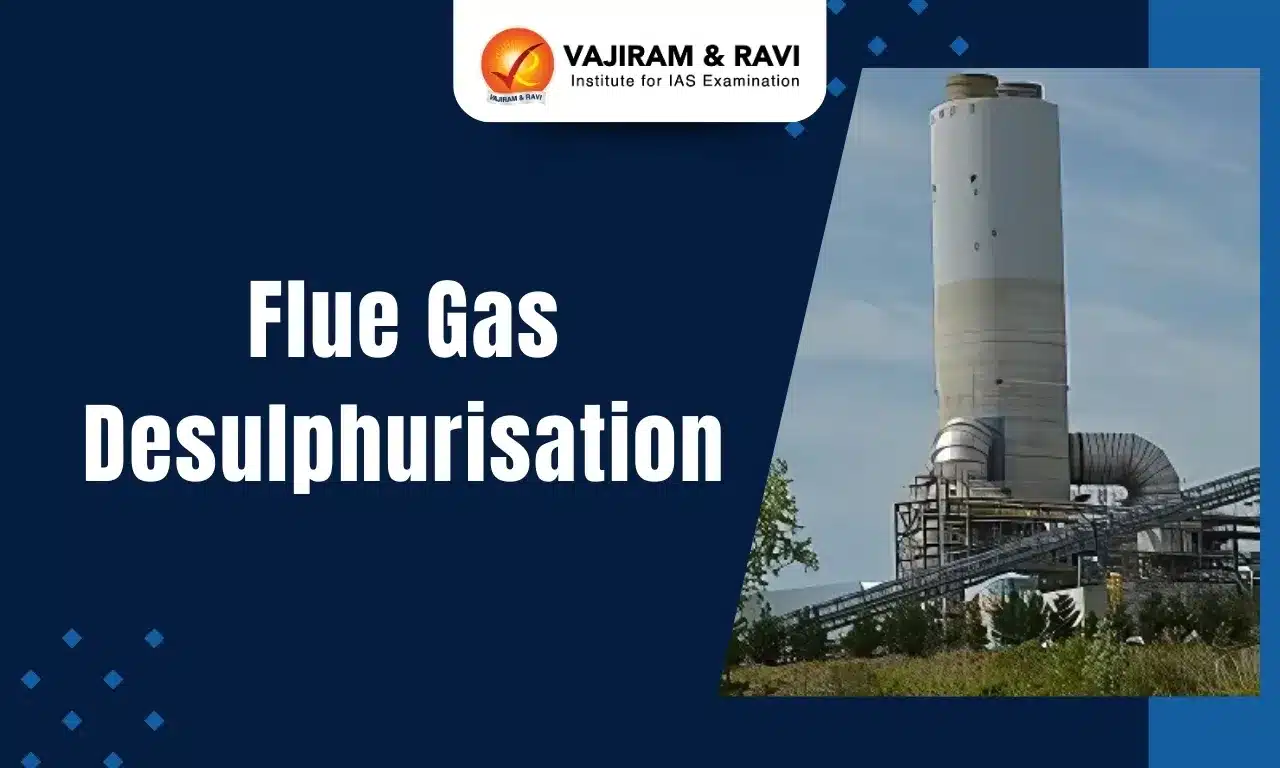Flue Gas Desulphurisation (FGD) Latest News
Recently, the Environment Ministry has exempted most coal-fired plants in India from installing Flue Gas Desulphurisation (FGD) systems aimed at reducing sulphur dioxide (SO2) emissions.
About Flue Gas Desulphurisation (FGD)
- Flue Gas Desulphurisation (FGD) is a pollution-control process that removes Sulphur Dioxide (SO₂) from the flue gases produced by the combustion of fossil fuels, especially coal.
- The key aim of FGD is to reduce SO₂ emissions, which are major contributors to acid rain and particulate matter pollution, harming crops, soil, water bodies, infrastructure, and human health.
- FGD systems typically use limestone (CaCO₃), lime (CaO), or ammonia (NH₃) to react with and neutralize SO₂ in flue gases.
FGD Technology Types
- Dry Sorbent Injection (DSI): Injects limestone or lime into the flue gas before it passes through dust collectors.
- Wet Limestone Scrubbing: Uses a slurry of limestone (CaCO₃) to absorb SO₂ and convert it into gypsum (CaSO₄·2H₂O).
- Seawater FGD: Uses the alkalinity of seawater to neutralise SO₂, common in coastal plants, with low installation costs but limited applicability.
Recent Policy Changes and Issues
- In 2015, India’s Environment Ministry mandated that all coal-fired thermal power plants must install FGD systems by 2017 to curb SO₂ pollution. There are about 180 such plants, comprising 600 individual units.
- This exemption decision was based on scientific studies suggesting:
- Indian coal has low sulphur content.
- SO₂ levels near plants with and without FGDs were similar.
- Sulphates may have a cooling effect, counteracting global warming.
- As of now, only ~8% of these units have installed FGDs, with most installations by NTPC (public sector). The rest failed due to vendor shortages, high costs, COVID-related delays, and an anticipated rise in power tariffs.
Source: TH
Last updated on December, 2025
→ Check out the latest UPSC Syllabus 2026 here.
→ Join Vajiram & Ravi’s Interview Guidance Programme for expert help to crack your final UPSC stage.
→ UPSC Mains Result 2025 is now out.
→ UPSC Notification 2026 is scheduled to be released on January 14, 2026.
→ UPSC Calendar 2026 is released on 15th May, 2025.
→ The UPSC Vacancy 2025 were released 1129, out of which 979 were for UPSC CSE and remaining 150 are for UPSC IFoS.
→ UPSC Prelims 2026 will be conducted on 24th May, 2026 & UPSC Mains 2026 will be conducted on 21st August 2026.
→ The UPSC Selection Process is of 3 stages-Prelims, Mains and Interview.
→ UPSC Result 2024 is released with latest UPSC Marksheet 2024. Check Now!
→ UPSC Prelims Result 2025 is out now for the CSE held on 25 May 2025.
→ UPSC Toppers List 2024 is released now. Shakti Dubey is UPSC AIR 1 2024 Topper.
→ UPSC Prelims Question Paper 2025 and Unofficial Prelims Answer Key 2025 are available now.
→ UPSC Mains Question Paper 2025 is out for Essay, GS 1, 2, 3 & GS 4.
→ UPSC Mains Indian Language Question Paper 2025 is now out.
→ UPSC Mains Optional Question Paper 2025 is now out.
→ Also check Best IAS Coaching in Delhi
Flue Gas Desulphurisation (FGD) FAQs
Q1. What is Flue Gas Desulphurisation (FGD)?+
Q2. Which substances are commonly used in FGD systems?+
Q3. What are the main types of FGD technologies?+
Tags: flue gas desulphurisation prelims pointers upsc prelims current affairs

















